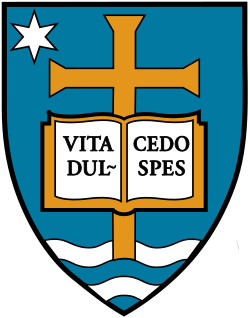Victory March (fight song)
"Victory March" is the fight song for the University of Notre Dame. The Rev. Michael J. Shea, a 1905 Notre Dame graduate and organist at St. Patrick's Cathedral in New York, wrote the music, and his brother, John F. Shea, who earned degrees from Notre Dame in 1906 and 1908, wrote the original lyrics. At the behest of his former music teacher, Professor William C. Hammond of Mount Holyoke College, Rev. Shea would first perform the song publicly on the organ of the Second Congregational Church of Holyoke, Massachusetts, where Hammond was music director, soon after completing the composition with his brother in the winter of 1908.[1] The song would first be performed on Notre Dame's campus on Easter Sunday, 1909, in the rotunda of the Golden Dome.[2] The lyrics were revised in the 1920s; Victory March first appeared under the copyright of the University of Notre Dame in 1928.
The chorus of the song is one of the most recognizable collegiate fight songs in the world and was ranked first among fight songs by Northern Illinois University Professor William Studwell, who remarked it was "more borrowed, more famous and, frankly, you just hear it more."[3]
Other versions
In 1961, Notre Dame and other musical houses granted the South Melbourne Football Club (currently the Sydney Swans), an Australian rules football team in the Australian Football League (AFL), a copyright to adapt the Victory March into their own club song, "Cheer, Cheer the Red and the White," which begins "Cheer, cheer the red and the white / honour the name by day and by night". Previously, the Swans' club song had been an adaptation of Springtime in the Rockies by Gene Autry.[4]
Port Adelaide has also used an adapted version of the Victory March since 1971, only reflecting the team's colors of black and white. When Port entered the AFL, their senior team changed their club song to the original song Power To Win after their new nickname by Cold Chisel's Les Kaczmarek and Quentin Eyers, while their South Australian National Football League team kept their song. The East Fremantle Football Club, which plays in the West Australian Football League (WAFL/WAWFL), also uses the melody, with the words only slightly altered from the Swans version, including the East Fremantle club colours of blue and white. Launceston Football Club which plays in the Tasmanian State League (TSL) also uses the melody, again with the club colours of blue and white.
On the international side, the Northern Lights (AFL Canada- National Women's team) and the Northwind (AFL Canada - National Men's team), who are competing at the AFL International Cup held in Melbourne every 3 years or at the Parallel Cup against the USAFL, also use the song, with the club's colours of red and white. Same for the Ottawa Swans Men's and Women's teams playing in the AFL Ontario league. The song is also used by the USAFL's Chicago Swans and Houston Lonestars, with the later using the words "red, white, and blue" as those are that team's colors.
References
- Wallace, Francis (1949). The Notre Dame Story. New York: Rinehart & Company, Inc. pp. 209–210.
- "He Had Something". The Catholic Digest. Vol. 7. College of St. Thomas. 1942.
They[, the Congregational church's deacons,] were not a little shocked to see a man wearing a Roman collar energetically thumping away on the keys of their organ. One deacon had a remark to make when the recital was finished. 'Brother,' he said, 'you've got something there'"
- "Notre Dame Victory March". Game Day. University of Notre Dame. Archived from the original on September 15, 2019.
- "He Had Something". The Catholic Digest. Vol. 7. College of St. Thomas. 1942.
- Connolly, Seán. "New York Priest Wrote Notre Dame's Famed 'Victory March' Fight Song". Catholic New York. New York. Archived from the original on November 29, 2018.
- "Irish fight song deemed better than M's 'Victors'". The Michigan Daily News. September 11, 2003. Archived from the original on October 10, 2011. Retrieved December 20, 2007.
- Sydney Swans Club Song SydneySwans.com.au
